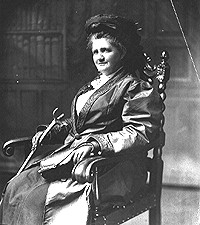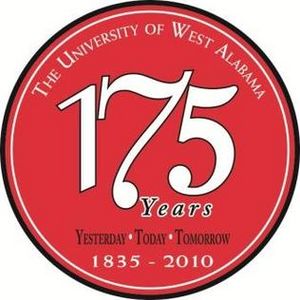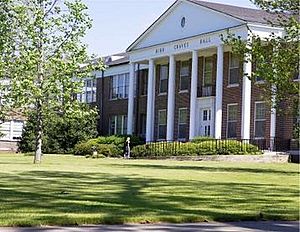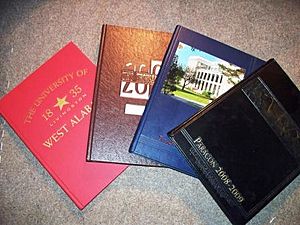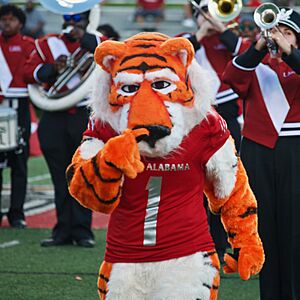University of West Alabama facts for kids
 |
|
|
Former names
|
Livingston Female Academy (1835–1878) Livingston Normal College (1878–1929) Livingston State Teachers College (1929–1957) Livingston State College (1957–1967) Livingston University (1967–1995) |
|---|---|
| Motto | "There's something about this place." |
| Type | Public university |
| Established | 1835 |
|
Academic affiliations
|
ACHE, SACS |
| Endowment | $375,613 |
| President | Ken Tucker |
| Provost | Tina Jones |
|
Academic staff
|
97 |
| Students | 5,157 |
| Location |
,
U.S.
32°35′24″N 88°11′10″W / 32.590°N 88.186°W |
| Campus | Rural, 600 acres (243 ha) |
| Colors | Red and white |
| Nickname | Tigers |
|
Sporting affiliations
|
NCAA Division II – Gulf South |
| Mascot | Luie the Tiger |
The University of West Alabama (UWA) is a public university located in Livingston, Alabama. It started in 1835 as a church-supported school for young women. It was first called the Livingston Female Academy.
Today, UWA helps students learn in many different subjects. Its campus covers about 600 acres in west-central Alabama. The university offers many types of degrees, from associate (two-year) to doctorate (highest level) degrees.
UWA's sports teams are called the West Alabama Tigers. They play in the Gulf South Conference and compete in NCAA Division II. The men's and women's rodeo teams compete in a different league called the National Intercollegiate Rodeo Association.
Contents
History of UWA
How it Started
The University of West Alabama began as the Livingston Female Academy in 1835. It welcomed its first students in 1839. The school was created by a group of Scots-Irish Presbyterians. Their main goal was to train future teachers. They also taught art, music, languages, and home economics.
Back then, tuition was $20 a year. Piano lessons cost an extra $25, and French or embroidery was $10 more. The first building, Jones Hall, was built in 1837. It was later destroyed by a fire in the 1890s. In 1840, the state officially recognized the academy.
The first diploma was given in 1843 to Elizabeth Houston. Dr. Robert Dickens Webb was a very important leader. He helped keep the school open during the American Civil War and the years after. The main administration building on campus is named after him.
In 1878, the school changed its name to Livingston Normal College. A famous education reformer, Julia Tutwiler, joined the staff in 1881. She helped get state money for women's education. Alabama was the first southern state to do this.
In 1883, the school was renamed the Alabama Normal College for Girls and Livingston Female Academy. This new name showed that it offered both two-year and four-year programs. "Normal training" meant teacher education back then.
Julia Tutwiler became the president of the college in 1890. She is the only woman to have held this position. She also helped other schools, like the University of Montevallo, and helped women get into the University of Alabama.
Becoming a State University
In 1915, men were allowed to attend the school as regular students. In 1922, Foust Hall was built as a lab school. Here, college professors taught, and students watched and helped in the classrooms.

In 1929, the Alabama State Board of Education took over the school. They renamed it the Livingston State Teachers College. A student newspaper, Campus Lights, was started that same year.
A football team was added in 1931. The college chose the tiger as its mascot, and its colors became red and white. The teams are still known as the UWA Tigers. The first homecoming celebration was held in 1939.
During World War II, fewer students enrolled, and the college almost closed. After the war, the school worked to recruit veterans. The GI Bill helped many servicemen pay for college. Tiger Stadium was built in 1952.
In 1957, the school's name changed again to Livingston State College. It started offering graduate-level classes and master's degrees.
Under President John E. Deloney (1963–1973), the campus grew a lot. It expanded to over 540 acres, including a 54-acre lake with nature trails. In 1967, the school became Livingston University with its own board of trustees. A historic covered bridge, the Alamuchee-Bellamy Covered Bridge, was moved to campus in 1969.
In 1973, Asa N. Green became president. He helped create the Ira D. Pruitt School of Nursing. He also started programs with other universities, like Auburn University, for marine biology. During the late 1970s, Lake LU was built on campus.
In the early 1980s, a new computer system was installed. The university celebrated its 150th anniversary in 1985–1986. Don C. Hines became president in 1994. He is remembered for bringing college rodeo to campus. The rodeo complex is named after him.
In 1995, the school changed its name to The University of West Alabama. This name better showed its role in the region. Ed Roach became president in 1998. He focused on bringing technology to UWA. He helped make UWA one of the first wireless campuses in the area.
UWA Today
Richard Holland, a UWA graduate, became president in 2002. He was the first UWA graduate to lead the university.
Student enrollment has continued to grow. In 2005, over 3,000 students were enrolled for the first time. By 2009, enrollment was almost 5,000. A new education center was added in Demopolis, Alabama, that same year.
What You Can Study
UWA offers more than 60 undergraduate programs and 10 graduate programs. These are offered through its different colleges and divisions:
- College of Business
- Julia Tutwiler College of Education
- College of Liberal Arts
- College of Natural Sciences and Mathematics
- Division of Online Programs
- Division of Technology
- Ira D. Pruitt School of Nursing
- School of Graduate Studies
Students can earn Bachelor of Arts, Bachelor of Science, Bachelor of Business Administration, Master's, and Educational Specialist degrees. The Ira D. Pruitt School of Nursing also offers an Associate degree.
Campus Life
The University of West Alabama is located in the center of Livingston, Alabama. The campus is on the western border of Alabama. Nearby cities include Meridian, Mississippi, and Tuscaloosa, Alabama. Livingston's small-town feel and Southern hospitality are something many students enjoy. The 600-acre campus has nature trails, a 54-acre lake, and sculptures.
Campus Buildings
The UWA campus has many buildings for different purposes:
- Math and Science Building: This building, once called Bibb Graves Hall, holds the College of Natural Sciences and Mathematics. It also has classrooms, labs, and the university's main auditorium.
- Brock Hall: This is home to the Ira D. Pruitt Division of Nursing.
- Lyon Hall: This building hosts the Julia Tutwiler College of Education. The University Charter School is also located here.
- Lucille Foust Hall: This building has offices and classrooms for the art department and band. It also houses the Athletic Department.
- Pruitt Hall: This is where the Physical Education and Athletic Training Department is located. It has classrooms, practice rooms, and studios for the music program.
- Guy Hunt Technical Education Complex and Hunt Annex: These buildings are used by the Division of Technology. They have classrooms, labs, and shop facilities.
- Julia Tutwiler Library: This library holds the university's books and other resources. It has study areas and a computer lab for students.
- Lurleen Burns Wallace Hall: This building is home to the College of Business and the College of Liberal Arts. It has classes for English, history, social sciences, and more.
Other important buildings on campus include:
- The Bell Conference Center: Used for special events and meetings.
- Kelly Hester Land Hall: Houses the Division of Educational Research.
- The President's Home: Where the university President lives.
- George C. Wallace Student Union Building (the SUB): Offers student activities and recreation. It has a weight room, pool, lounge, computer lab, bookstore, and post office.
- Webb Hall: The main building for the university's administrative offices.
- Young Hall (the CAF): This building houses the campus dining hall and kitchens.
- The Armory: Contains the university's campus police and the UWA campus school for young children.
Student Life and Fun
Living on Campus
While not required, UWA encourages students to live in a residence hall during their first two years. Research shows that students who live on campus are more likely to graduate. Some students, like those with certain scholarships or athletes, may be required to live on campus.
Media and Entertainment
The official student newspaper is Muse. Students publish it weekly with help from faculty. It started in 1940 as Livingston Life. Students also create The Paragon, the official university yearbook.
The Sucarnochee Review is a journal for creative writing and art. It is published by the university's Department of Languages and Literature. Students also help with this journal. The university's theatre program puts on two plays each year, performed by students.
UWA also has Studio 96, which provides educational video services. Students produce a weekly local news show called TIGER PAUSE. You can watch it on their YouTube channel, studio96productions.
Student Groups
The University of West Alabama has over 50 student organizations and honor societies. Students can choose from many different groups. These include athletic support groups, music groups, religious groups, and special interest clubs. There are also many honor societies for students who do well in their studies.
Greek Life
UWA has a Greek system with 6 fraternities and 7 sororities. These groups do a lot of charity work and offer social activities for students. New members join at the start of every fall semester.
IFC Fraternities
- Delta Chi
- Sigma Pi
Panhellenic Sororities
- Alpha Sigma Alpha
- Alpha Sigma Tau
- Phi Mu
National Pan–Hellenic Organizations
Sororities
- Alpha Kappa Alpha
- Delta Sigma Theta
- Zeta Phi Beta
- Sigma Gamma Rho
Fraternities
- Alpha Phi Alpha
- Kappa Alpha Psi
- Phi Beta Sigma
- Omega Psi Phi
Sports and Traditions
The University of West Alabama has 12 sports teams. Both the male and female teams are called the West Alabama Tigers. Ten of the teams compete in NCAA Division II as part of the Gulf South Conference. The men's and women's rodeo teams compete in a different league.
NCAA Division II sports at UWA include:
- For men: baseball, basketball, cross country, football, golf, outdoor track, soccer, and tennis.
- For women: basketball, cross country, golf, soccer, softball, tennis, outdoor track, and volleyball.
The university's official mascot is Luie the Tiger.
In 1971, the football team won the school's first national championship. The women's rodeo team won a national championship in 2023. In 1992, the baseball team made it to the Division II College World Series. The Tiger softball program made it to the national tournament in 1997.
The men's and women's basketball teams have each been to the NCAA Tournament twice. The football team made it to the NCAA Division II Championship in 2009, 2011, 2012, and 2017. In 2017, the men's soccer team reached the Sweet 16 of the NCAA Division II tournament.
Besides varsity sports, the university offers many intramural sports programs. These are sports played for fun among students. An 18-hole disc golf course was recently added to the campus.
Famous People from UWA
Many notable people have attended or worked at the University of West Alabama:
- Mickey Andrews, former Head Coach for Livingston University's 1971 National Championship Football Team.
- Jeff Branson, a retired Major League Baseball player.
- Malcolm Butler, a former NFL cornerback for the New England Patriots and Tennessee Titans.
- Otha Foster, a player in the Canadian Football League.
- Jonathan Solofa Fatu Jr and Joshua Samuel Fatu, famous wrestlers in the WWE.
- Tyreek Hill, an NFL wide receiver for the Miami Dolphins.
- Andrew Killgore, a former U.S. Ambassador to Qatar.
- Charles Martin, a retired NFL defensive tackle.
- Buddy Nix, a former General Manager for the Buffalo Bills.
- Tanner Rainey, an MLB Pitcher for the Washington Nationals.
- Seth Roberts (American football), an NFL wide receiver.
- Stelio Savante, a Hollywood actor.
- Lois Wilson, a silent movie star and Miss Alabama in the 1920s.


